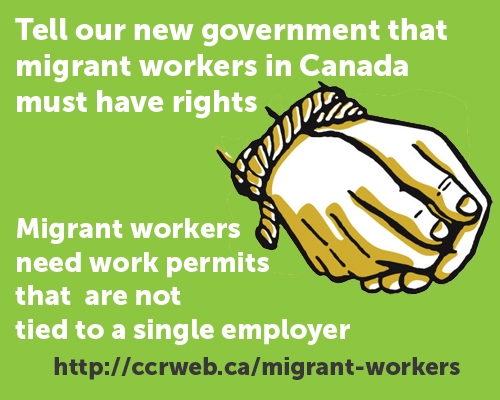Looking back on changes in 2014
While 2013 was marked by provincial action, 2014 has been a year marked by federal government changes to the migrant worker reality.
May: The government announced a moratorium on using migrant workers in the restaurant industry.
June: The government announced a major overhaul to the Temporary Foreign Worker Program (TFWP) as a whole.
September: The government published a discussion paper with a proposed compliance framework for employers who break the rules.
November: The government announced changes to the Caregiver Program (formerly Live-in Caregiver Program).
In presenting the changes, the government has emphasized the potential benefits for Canadian workers and the economy. For the CCR, protecting migrant workers’ rights should be the primary focus of changes.
Specific concerns include the following:
- Workers’ time in Canada will be cut even shorter. The government has announced that it will reduce still further the four-year limit first imposed in 2011. This time limit, which only applies to workers in the low-wage stream, exacerbates existing vulnerabilities.
- Workers may be penalized for their employer’s wrongdoing. The government plans to revoke employers’ Labour Market Impact Assessment if they violate the rules, but has announced no measures to protect migrant workers in their employ. They will lose their work permits and their status, and be at risk of deportation.
- Caregivers lose guaranteed right to permanent residence. The introduction of caps on permanent residence applications in the program means that some caregivers will now be excluded from access to permanent residence. This represents a step backward.
Details of CCR concerns are found in:
Looking forward to 2015
April 2015 will be four years since the four-year limit on migrant workers’ stay in Canada was imposed in April 2011. This means that many Temporary Foreign Workers will lose their right to work in Canada. There is concern over the hardship this will likely cause to affected workers, especially those whose families depend on their remittances, or who are still repaying debts from recruitment fees (illegally imposed on them). Some workers may choose to remain in Canada and seek more precarious work, without access to status or services, in order to keep providing for their families back home.
The CCR believes that Canada’s reliance on temporary labour migration programs is problematic because it compromises migrants’ rights, when all migrant workers should have access to permanent residence.
Our vision for 2015 includes:
- Government priority to protecting the rights of vulnerable migrant workers.
- Access to permanent residence for all migrant workers.
- An economic immigration program expanded to reflect the broad range of labour needs of the Canadian economy by including workers of all skill levels, including those currently entering on a temporary basis to fill low-wage jobs.
In the past, Canada has focused on nation-building through permanent immigration. The CCR believes that Canada should move back towards such a model, and away from the temporary migration that promotes a two-tiered, stratified society.


